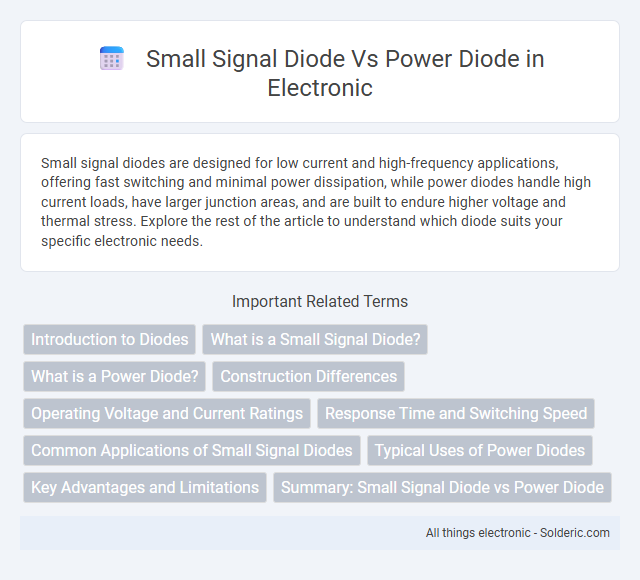Small signal diodes are designed for low current and high-frequency applications, offering fast switching and minimal power dissipation, while power diodes handle high current loads, have larger junction areas, and are built to endure higher voltage and thermal stress. Explore the rest of the article to understand which diode suits your specific electronic needs.
Comparison Table
| Feature | Small Signal Diode | Power Diode |
|---|---|---|
| Purpose | Signal detection and switching in low current circuits | Rectification and power handling in high current circuits |
| Current Rating | Up to a few hundred milliamps (mA) | Several amperes (A) to kiloamperes (kA) |
| Voltage Rating | Low to medium voltage (up to ~100V) | High voltage (hundreds to thousands of volts) |
| Switching Speed | Very fast, suitable for high-frequency operation | Slower due to larger junction area and capacitance |
| Physical Size | Small and compact | Large with heat sinks for thermal management |
| Power Dissipation | Low power dissipation | High power dissipation capability |
| Applications | Radio signal demodulation, logic circuits, switching | Power rectifiers, motor drives, power supplies |
Introduction to Diodes
Small signal diodes are designed for low current, high-frequency applications such as signal modulation and switching, whereas power diodes handle high current and voltage in power rectification and regulation. The key differences lie in their construction, with small signal diodes featuring a thin junction for fast response times, and power diodes having a thicker junction to withstand higher stress. Your choice between these diodes depends on the electrical demands of your circuit, ensuring efficiency and reliability.
What is a Small Signal Diode?
A Small Signal Diode is a semiconductor device designed to operate at high frequencies with low current and voltage levels, typically used in signal processing applications such as switching, clipping, and detection. It features a small junction area and low capacitance, allowing rapid response times and minimal distortion in AC signals. These diodes are commonly found in radio frequency circuits, amplifiers, and mixers where precise signal handling is crucial.
What is a Power Diode?
A power diode is a semiconductor device designed to handle high current and voltage levels in power electronics applications, such as rectifiers, voltage regulation, and power conversion. Unlike small signal diodes, power diodes feature larger junction areas and robust construction to manage significant thermal dissipation and withstand high reverse voltages. Your electronic circuits benefit from power diodes when efficient conduction and reliable performance under heavy load conditions are essential.
Construction Differences
Small signal diodes are constructed with a thin semiconductor junction and small size to handle low currents and high-frequency signals efficiently. Power diodes feature a thicker semiconductor layer and larger junction area designed to withstand high voltage and current loads, enhancing durability and heat dissipation. Understanding these construction differences helps you select the appropriate diode type for your specific electronic circuit requirements.
Operating Voltage and Current Ratings
Small signal diodes typically operate at low voltages ranging from a few volts up to around 100V and handle currents in the milliampere range, making them ideal for signal processing and switching applications. Power diodes, on the other hand, are designed for high voltage operations often exceeding 1000V and can carry currents from several amperes to hundreds of amperes, suited for power rectification and voltage regulation. Understanding the operating voltage and current ratings of these diodes is crucial for selecting the right component to protect your circuit and ensure efficient performance.
Response Time and Switching Speed
Small signal diodes exhibit extremely fast response times and high switching speeds, typically in the nanosecond range, making them ideal for high-frequency applications such as RF circuits and signal processing. Power diodes, designed to handle higher currents and voltages, have slower switching speeds often in the microsecond range due to larger junction capacitances and charge storage effects. The significant difference in response time between small signal and power diodes impacts their suitability for circuits requiring rapid switching versus high power handling capability.
Common Applications of Small Signal Diodes
Small signal diodes are primarily used in high-frequency applications such as signal processing, switching, and mixing in radios and communication devices. They excel in low current, low voltage environments where fast switching speeds and minimal capacitance are crucial. Typical examples include waveform clipping, voltage regulation in small circuits, and protection of sensitive components against voltage spikes.
Typical Uses of Power Diodes
Power diodes are commonly used in applications requiring high current and voltage handling, such as rectifiers in power supplies, freewheeling diodes in motor drives, and protection devices in industrial equipment. Their robust construction enables efficient switching in power conversion systems, ensuring reliable operation under demanding electrical loads. You can find power diodes in renewable energy inverters, electric vehicle controllers, and high-voltage DC transmission systems.
Key Advantages and Limitations
Small signal diodes excel in high-speed switching and low current applications, offering fast response times and minimal power loss, ideal for signal processing and rectification in low voltage circuits. Power diodes handle higher voltages and currents, making them suitable for power rectification and protection, but they exhibit slower switching speeds and larger physical size. Your choice depends on balancing the need for speed and low power consumption with the requirement for handling high power in demanding electrical systems.
Summary: Small Signal Diode vs Power Diode
Small signal diodes are designed for high-speed switching and low current applications, typically below 100mA, with fast recovery times and low capacitance. Power diodes handle higher currents, often above several amperes, and withstand high voltage, making them suitable for rectification in power supplies and motor drives. Your choice depends on the application's current and voltage requirements, switching speed, and power dissipation needs.
Small Signal Diode vs Power Diode Infographic

 solderic.com
solderic.com